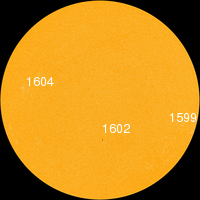QUIET SUN: With no sunspots actively flaring, tthe sun's x-ray outut has flatlined. Solar activity is very low and likely to remain so for the next 24 hours. Solar flare alerts: text, voice.
TAURID FIREBALLS: Sky watchers should be alert for fireballs in the nights ahead. Forecasters say Earth is entering a swarm of gravelly debris from comet Encke. Meteoroids the size of pebbles and small stones hitting Earth's atmosphere at 25 km/s are producing a slow drizzle of very bright fireballs flying out of the constellation Taurus. The display is expected to peak with a few fireballs every hour during the nights of Nov. 5-12.
On Nov. 2nd, Salvador Aguirre photographed a Taurid fireball streaking over Hermosillo, Mexico. Circled, the fireball was even brighter than the nearby Moon:
"Este fue un Gran Fireball!" says Aguirre, who estimates its astronomical magnitude to be -18. This means the fireball was 100 times brighter than a full Moon (magn. -13). To capture the Taurid, he used an All Sky Sentinel camera on loan from the Sandia National Laboratories.
"What always strikes me about the Taurids," notes Bill Cooke of NASA's Meteoroid Environment Office, "is how deeply they penetrate Earth's atmosphere. On average, they make it down to an altitude of 44 miles. Contrast this to the recent Orionids, which burn up at an average altitude of 58 miles. Part of this is due to the speed difference: Taurids are slow (27 km/s) while Orionids are fast (66 km/s). In addition, many Taurids are made up of stronger stuff than the Orionids."
Cooke encourages sky watchers to observe the Taurids and report their fireball counts to NASA using the Meteor Counter app--now available for Apple and for Android devices.

![]()
Solar wind
speed: 300.5 km/sec
density: 1.1 protons/cm3
explanation | more data
Updated: Today at 1907 UT
![]()
X-ray Solar Flares
6-hr max: B2 1555 UT Nov04
24-hr: B2 1218 UT Nov04
explanation | more data
Updated: Today at: 1900 UT
![]()
![]()
![]()
Daily Sun: 04 Nov 12
![]()
![]()
None of these sunspots is actively flaring. Solar activity is low. Credit: SDO/HMI
![]()
![]()
![]()
Sunspot number: 35
What is the sunspot number?
Updated 03 Nov 2012
Spotless Days
Current Stretch: 0 days
2012 total: 0 days (0%)
2011 total: 2 days (<1%)
2010 total: 51 days (14%)
2009 total: 260 days (71%)
Since 2004: 821 days
Typical Solar Min: 486 days
Update 03 Nov 2012
The Radio Sun
10.7 cm flux: 97 sfu
explanation | more data
Updated 03 Nov 2012
![]()
![]()
![]()
Current Auroral Oval:
![]()
Switch to: Europe, USA, New Zealand, Antarctica
Credit: NOAA/POES
![]()
![]()
![]()
Planetary K-index
Now: Kp= 0 quiet
24-hr max: Kp= 1 quiet
explanation | more data
![]()
Interplanetary Mag. Field
Btotal: 5.2 nT
Bz: 3.9 nT north
explanation | more data
Updated: Today at 1904 UT
![]()
![]()
![]()
Coronal Holes: 03 Nov 12
![]()
![]()
A minor solar wind stream flowing from the indicated coronal hole should reach Earth on Nov. 4-5. Credit: SDO/AIA





